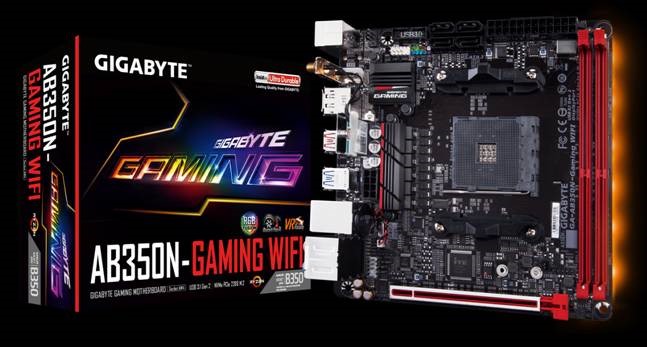Gigabyte Goes SFF With AB350N-Gaming WiFi Mini-ITX Motherboard
Gigabyte unveiled the AB350N-Gaming WiFi motherboard. If you have plans to build a Ryzen-based small form factor (SFF) system, this motherboard will certainly be of interest to you.
Although small in size, the AB350N-Gaming WiFi is loaded with everything but the kitchen sink. In addition to standard features found on other mainstream AM4 socket motherboards, such as support for AMD's Ryzen and 7th Generation A-series processors, DDR4 support up to 3,200MHz, a single PCI-E x16 3.0 slot, USB 3.1, and 7.1 Channel HD audio, this board features a redesigned CPU socket area built specifically to accommodate larger heatsinks such as AMD’s Wraith Max cooler.
Henry Kao, the Vice President of Gigabyte’s Motherboard Business Unit, stated:
Gigabyte has been building strong relationships with AMD. When AMD published the latest Wraith Max, we released a corresponding model to meet the demand. Even more so, Gigabyte’s R&D put great efforts on re-arranging the components on the board in order to make mini motherboards achieve optimal compatibility for larger thermal cooling solutions. In the future, we will continue to cooperate with AMD and create more unique, creative products to address the demands from gamers and enthusiasts.
This mini-ITX motherboard is outfitted with the company's Smart-Fan 5 that enables you to manually change fan profiles for each fan header, or you can allow the software to control system temperatures automatically by reading thermal sensors on the motherboard and adjusting fan speeds accordingly.
The hybrid fan pin headers support both standard type voltage fans and PWM fans. The motherboard supports high current fans up to 24W with built-in over-current protection. The company stated that this makes the motherboard more "liquid cooling friendly."
The RGB Fusion feature has a variety of different preset lighting configurations. Users can even set the motherboard lighting to synchronize with Wraith Max coolers or have them change colors to indicate CPU temperature. There are two separate light zones capable of seven different lighting effects (color cycle, pulse, music, static, flash, and intelligent). The RGB Fusion app can be downloaded directly from the company website.
Get Tom's Hardware's best news and in-depth reviews, straight to your inbox.
Other features include IR digital power controllers and PowIRstage ICs, server level chokes, an onboard 802.11ac Intel WiFi module with Bluetooth 4.2 support, high-end Chemicon audio capacitors, HD audio with smart headphone amp, Realtek GbE LAN, and Gigabyte's patented double locking PCI-E bracket with a one piece stainless steel shield
We have reached out to Gigabyte for information on pricing and availability.
| Header Cell - Column 0 | Gigabyte AB350N-Gaming WiFi |
|---|---|
| Socket | AM4 |
| Chipset | B350 |
| Form Factor | Mini-ITX |
| Expansion Slots | 1 x PCI Express x16 slot, running at x16(The PCIEX16 slot conforms to PCI Express 3.0 standard.)1 x M.2 Socket 1 connector for the wireless communication module |
| Memory Support | 2 x DDR4 DIMM Sockets Support Up To 32 GBSupport for DDR4 3200/2933/2667/2400/2133 MHzSupport for higher than DDR4 2667 MHz may vary by CPU.Support for ECC Un-buffered DIMM 1Rx8/2Rx8 memory modulesSupport for non-ECC Un-buffered DIMM 1Rx8/2Rx8/1Rx16 modulesSupport for Extreme Memory Profile (XMP) memory modules |
| Onboard Graphics | 1 x DisplayPort4096x2304@60Hz Maximum Resolution* Support for DisplayPort 1.2 version.1 x HDMI port 4096x2160@24Hz Maximum Resolution* Support for HDMI 1.4 version.Maximum shared memory of 2 GB* Actual support may vary by CPU |
| Audio | Realtek ALC1220 codecHigh Definition Audio2/4/5.1/7.1-channelSupport for S/PDIF Out |
| LAN | Realtek GbE LAN chip (10/100/1000 Mbit) |
| Storage | 1 x M.2 Socket 3 connector on the back of the motherboard (Socket 3, M key, type 2260/2280 SATA and PCIe x4*/x2 SSD support)4 x SATA 6Gb/s connectorsSupport for RAID 0, RAID 1, and RAID 10* Actual support may vary by CPU. |
| USB | Chipset:2 x USB 3.1 Gen 2 Type-A ports (red) on the back panel2 x USB 3.1 Gen 1 ports available through the internal USB header4 x USB 2.0/1.1 ports (2 ports on the back panel, 2 ports available through the internal USB header)Integrated in the CPU:4 x USB 3.1 Gen 1 ports on the back panel |
| I/O | 1 x PS/2 keyboard/mouse port2 x SMA antenna connectors1 x DisplayPort1 x HDMI port2 x USB 2.0/1.1 ports2 x USB 3.1 Gen 2 Type-A ports (red)4 x USB 3.1 Gen 1 ports1 x RJ-45 port6 x audio jacks |
| Wireless | Wi-Fi 802.11 a/b/g/n/ac, supporting 2.4/5 GHz Dual-BandBLUETOOTH 4.2, 4.1, BLE, 4.0, 3.0, 2.1, 2.1+EDRSupport for 11ac wireless standard and up to 433 Mbps data rate* Actual data rate may vary depending on environment and equipment. |
| Lighting | Gigabyte RGB Fusion |
| Price | TBA |
Steven Lynch is a contributor for Tom’s Hardware, primarily covering case reviews and news.

